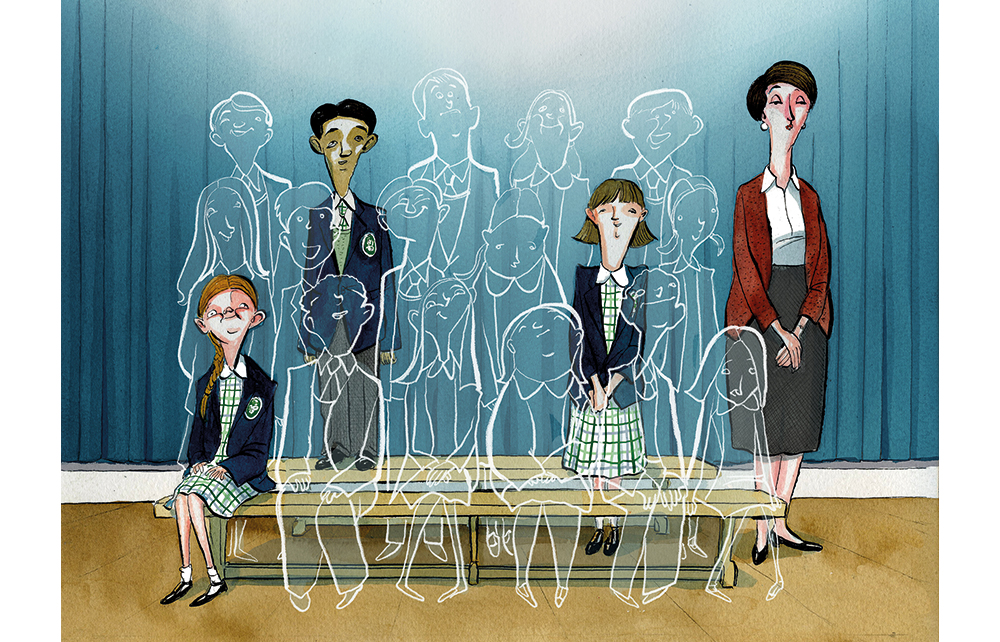‘There was this guy in my year who never came back to school after lockdown,’ a 14-year-old girl at a comprehensive in the Midlands says. ‘Then one day my friends and I saw him by the shopping centre. He was, like, sitting on a piece of cardboard by the side of the road, looking a bit homeless. Other kids recognised him and bought him food and clothes. He’d always been popular. Then someone told a teacher and a couple of days later he came back to class. But he was so far behind, he grew frustrated and angry, and then one day he just upped and left for good.’
That boy is a ghost child – a victim of the disastrous policy of school closures during the Covid pandemic. On 8 March 2021, when schools reopened, everyone expected that it would be business as usual. They assumed children would skip back into class and resume their education.
A new report from the Centre for Social Justice, Lost and Not Found, shows just how wrong those assumptions were. In fact, many tens of thousands of children have gone missing. Two years on and growing numbers are still abandoning education altogether. It’s an effect no one anticipated and few understand. Worse, no one seems very interested. It’s why, over the past year or so, I have been trying to document the story that political parties refuse to address.
Lockdowns proved a disaster for young people at every stage of their development. With all the attention on the elderly, the young were left to cope on their own. It was assumed they’d be resilient. Far from it.
‘Lockdown has derailed their plans. The pandemic has diminished their life chances’
A school counsellor told me that the countless kids sent to him for help fall into two groups. Either they are so crippled by anxiety or depression that they cannot leave the house, or they are angry and bitter, out on the streets and into crime and gangs. One 14-year-old girl told me: ‘I just sit in my room. It’s an awful feeling, like really scary and lonely.’ A 16-year-old boy I met on Streatham high street, hoodie pulled up over his afro, said: ‘I’m upset I lost so much learning. I’m stressed I didn’t get the grades I needed for college.’
In the last full school term – the autumn of 2019, shortly before the start of the pandemic – just 60,202 pupils were defined as ‘severely absent’: that is, spending more time out of classrooms than in them. Since then, and despite schools opening, this number has shot up. Now 140,000 children are classed as ‘severely absent’, according to the analysis of official figures by the CSJ – a rise of 134 per cent, or the equivalent of around 140 schools. Despite recent efforts their numbers have continued to surge. Children are turning their backs on education ‘at an alarming pace’, warns the CSJ.
A certain percentage of children have always dropped out of school. Fifteen years ago, I got to know four members of a south London gang who, at the age of 15, had swapped lessons for drug dealing and mugging. They have been in and out of prison ever since, at great cost to the state and to themselves. Young people destitute of hope and qualifications are likely to turn to crime. Some 90 per cent of young offenders and 59 per cent of prisoners regularly played truant from school.
Is this the future for the pandemic’s ghost children? And how will the state deal with the sheer numbers of young people dropping out of society? As one young man said to me: ‘We are all kicking off now.’
It is no surprise that the most vulnerable are more likely to become ghost children. Pupils on free school meals or living in the most disadvantaged areas have a persistent absence rate double that of their better-off contemporaries. One man who provides alternative provision to young people in London admitted that, of his 14 pupils, all but three had failed to return.
But it is not just the usual suspects. Ghost children also exist among the high-achieving middle classes. One teacher in a London suburb at an all-girls school rated ‘outstanding’ by Ofsted told me: ‘The mental health issues among my girls is a pandemic in itself.’ A third of pupils only turn up intermittently; 30 girls have actually gone missing. Before the pandemic, the school expected many of these girls to go to university and enjoy a career. But lockdown, the teacher says, ‘totally derailed their plans. Their parents would say their characters have changed. They are a different person now. The pandemic has diminished their life chances’.
Her school is not alone. Absence is now a feature of school life. Just under two million pupils – one in four of all school children – are classified as ‘persistently absent’ (i.e. have an attendance rate of less than 90 per cent) – double pre-pandemic levels. The teacher explained that one single mother has had to give up her job ‘to concentrate full-time on coaxing her daughter back into school’ despite the fact ‘she is the breadwinner so it means real financial hardship’.
The attitude of schools and staff during lockdown was crucial to the well-being of the young people I interviewed – and whether they have returned since. No surprise that pupils at failing schools
were more likely to receive little support. But it appears to be entirely arbitrary whether schools provided education and help. It varied from school to school, and even from teacher to teacher. One girl told me her geography tutor had been really helpful, but that she had barely heard from the English staff. A boy described the impact of school indifference on his mood. ‘The teachers didn’t mark the work I had completed – not once,’ he says. With no feedback, this clever and competitive boy lost motivation. Confined to his room, he started to listen to rap music, which fuelled his frustration and rage. When school reopened, it was only the intervention of his parents and months of counselling that turned him around. ‘I was scared I had lost myself forever and become a different version of myself.’
‘It breaks my heart looking at the kids in my class. Basically they are just not happy’
That the Department for Education allowed such a variation of response from schools is shocking. It was surely its job to ensure all schools provided a basic standard of education for all children. This official indifference is now extending to the new regiment of ghost children. Young people who dropped out of school, as I saw firsthand with my gang, are no one’s responsibility. Numbers are expanding but no government institution is charged with their care – until they enter the criminal justice system, that is. Children’s Commissioners do a good job at articulating the issue but they lack real power to make a difference.
Young people moving on to sixth-form college are particularly vulnerable. A teacher in the north-east of England says she has noticed the disappearance of a number of 16- and 17-year-olds from lessons. They enrolled in the sixth form in September, ‘but I have never seen them’. She says parents always give the same reason for their child’s absence – their mental health is too fragile for them to attend class. Parents are at a loss and teachers are instructed by the authorities not to pursue an absence if it is for mental health reasons. ‘We are told to just leave it. You hope the services are there in the background. But we know they aren’t.’
The disjointedness of it all, and the lack of data gathering, is another risk factor. After the age of 16, we expect older children to stay in education or to pursue vocational training but there is no way of making sure they do this, or of recording what has happened to them. Children are falling through a gap in the system into a black hole.
Meanwhile, as the CSJ report makes clear, the number of ghost children is set to multiply and will continue to do so for many years. This is due to the disastrous impact of lockdown on babies and young children who are now making their way through the education system. As one primary school teacher said to me: ‘It breaks my heart looking at the kids in my class. Either they are crippled with anxiety or jumping off the walls. Basically they are just not happy.’
The head of one primary school explained to me: ‘Usually, around half of pupils arrive at primary school not ready to start lessons. After lockdown, this jumped to more than 80 per cent.’ Teachers are baffled to find four-year-olds barely able to say their name and still in nappies. They were quick to blame parents. No one mentioned how the complete absence of statutory services over the pandemic took its toll.
Lockdown all but halted early years provision. Drop-in baby and toddler groups stopped. Parks and playgrounds were closed long after we knew the virus didn’t spread outside. Even more extraordinary, health visitors, a vital service and lifeline for new parents, largely disappeared – as did many GPs. New mothers were riddled with anxiety: were their babies feeding properly, gaining weight? And, that crushing fear for every new mother, did their baby have a disability? They had no one to ask. As one new mother said: ‘I feel very isolated and frightened. This is my first child, I don’t know what normal is and I don’t know where to find help.’
Nearly every mother I spoke to described how the isolation had worn them down and damaged their ability to parent. They saw this reflected in their children’s behaviour. ‘Often a child was on its own all day with a very angry, stressed and anxious adult,’ points out Tess Bailey-Sayer, CEO of Sea Change Trust, a psychotherapy charity for the young. ‘Children are utterly dependent on their parents’ sense of wellbeing and stability for their own sense of wellbeing and stability. It is like their weather system. The child doesn’t have the resilience to cope on its own. Some families became war zones and you are seeing the fallout in the schools.’ This will be the case for years to come, she warned.
Parenting Circle, a charity which aims to improve children’s school readiness, points out that a five-year-old who cannot play happily or speak properly is more likely to grow into a nine-year-old bully, then the 13-year-old with poor school attendance, the 15-year-old who joins a gang and, finally, the 19-year-old behind bars. Unless serious remedial steps are taken to bring back the ghost children and to stop their numbers growing, that will be their future. It’s
a disaster for our society.






Comments